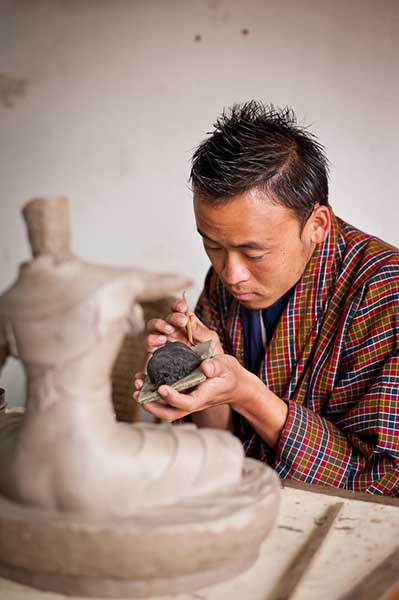 Art, architecture and culture are a unique facet of this Himalayan nation. It’s architectural style is displayed in the way houses, monasteries, Dzongs (fortresses) are built. Ancient structures, most importantly Dzongs, were built without prior planning or modern engineering techniques. In fact, the builders didn’t even use nails. At present, buildings have to fit certain architectural guidelines as per government laws so that the country’s architectural style is preserved.
Art, architecture and culture are a unique facet of this Himalayan nation. It’s architectural style is displayed in the way houses, monasteries, Dzongs (fortresses) are built. Ancient structures, most importantly Dzongs, were built without prior planning or modern engineering techniques. In fact, the builders didn’t even use nails. At present, buildings have to fit certain architectural guidelines as per government laws so that the country’s architectural style is preserved.
The thirteen Bhutanese arts and crafts that have been in practice since time immemorial are known as The Zorig Chusum. They comprise:
- Thag zo – the art of weaving rich, colorful textiles is prevalent especially in the central and eastern parts of Bhutan, ex. bura, kishuthara, yathra, mathra.
- Tsha zo – weaving of bamboo and cane products such as baskets, mats, containers, winnowers.
- Shag zo – making of wooden bowls from special wooden knots.
- Lhag zo – paintings capturing imagery of the Bhutanese landscape.
- Shing zo – carpentry.
- Do zo or stonework – Classic examples of stonework are Chorten Kora in Trashiyangtse, eastern Bhutan and Chendebji chorten, central Bhutan.
- Par zo – major carvings carried out on stone, wood and slate.
- Jim zo – involves sculpture of works in clay. Statues of deities, gods and goddesses and other prominent religious figures exemplify clay work in Bhutan.
- Lug zo – is believed to be introduced by a Tibetan saint known as Dupthob Thangtong Gyalpo. He used bronze to cast containers such as cups, urns, and vases. People also shaped bronze into weapons and armor namely battle-axes, helmets, knives, swords and shields.
- Troe ko or ornament crafting – is a skill that has produced beautiful jewelry widely used by Bhutanese women.
- De zo – the art of making traditional paper from the bark of the Daphne tree.
- Tshem zo – the art of embroidery and appliqué normally practiced by monks which they use to produce religious scrolls known as Thangkas.
- Tsho lham – the art of traditional boot making
Bhutan has two Zorig Chusum institutes: one in Thimphu, the capital and one in the far-flung eastern district of Trashiyangtse.
The Bhutanese costume for men (gho) and women (kira) are unique and the people take great pride in wearing them. The gho is akin to a short skirt with a “great pocket” while the kira can be intricately patterned. It is worn with “wonju” an inner blouse and a “tego” outer jacket that is secured by a broach. Both the gho and kira are firmly held in place by a “kera” (belt) tied at the waist.
All government offices require that its employees wear the national dress and on festive occasions like the “Tsechu” where crowds gather to receive blessings or witness masked dances. Men and women in ghos and kiras can be seen in their resplendent colorful glory.
